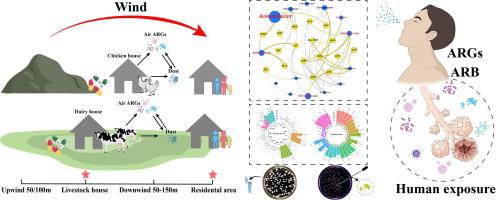Environment International ( IF 10.3 ) Pub Date : 2021-10-18 , DOI: 10.1016/j.envint.2021.106927 Hong Bai 1 , Liang-Ying He 1 , Dai-Ling Wu 2 , Fang-Zhou Gao 1 , Min Zhang 1 , Hai-Yan Zou 1 , Mao-Sheng Yao 3 , Guang-Guo Ying 1

|
Animal farms have been considered as the critical reservoir of antibiotic resistance genes (ARGs) and antibiotic resistant bacteria (ARB). Spread of antibiotic resistance from animal farms to the surrounding environments via aerosols has become a growing concern. Here we investigated the dispersal pattern and exposure risk of airborne ARGs (especially in zoonotic pathogens) in the environment of chicken and dairy farms. Aerosol, dust and animal feces samples were collected from the livestock houses and surrounding environments (upwind and downwind areas) for assessing ARG profiles. Antibiotic resistance phenotype and genotype of airborne Staphylococcus spp. was especially analyzed to reveal the exposure risk of airborne ARGs. Results showed that airborne ARGs were detected from upwind (50 m/100 m) and downwind (50 m/100 m/150 m) air environment, wherein at least 30% of bacterial taxa dispersed from the animal houses. Moreover, atmospheric dispersion modeling showed that airborne ARGs can disperse from the animal houses to a distance of 10 km along the wind direction. Clinically important pathogens were identified in airborne culturable bacteria. Genus of Staphylococcus, Sphingomonas and Acinetobacter were potential bacterial host of airborne ARGs. Airborne Staphylococcus spp. were isolated from the environment of chicken farm (n = 148) and dairy farm (n = 87). It is notable that all isolates from chicken-related environment were multidrug-resistance (>3 clinical-relevant antibiotics), with more than 80% of them carrying methicillin resistance gene (mecA) and associated ARGs and MGEs. Presence of numerous ARGs and diverse pathogens in dust from animal houses and the downwind residential areas indicated the accumulation of animal feces origin ARGs in bioaerosols. Employees and local residents in the chick farming environment are exposed to chicken originated ARGs and multidrug resistant Staphylococcus spp. via inhalation. This study highlights the potential exposure risks of airborne ARGs and antibiotic resistant pathogens to human health.
中文翻译:

空气中抗生素耐药性从动物农场传播到环境:传播模式和暴露风险
动物养殖场被认为是抗生素抗性基因 (ARG) 和抗生素抗性细菌 (ARB) 的关键储存库。抗生素耐药性通过气溶胶从动物农场传播到周围环境已成为一个日益受到关注的问题。在这里,我们调查了鸡场和奶牛场环境中空气传播的 ARGs(尤其是人畜共患病病原体)的传播模式和暴露风险。从畜舍和周围环境(上风和下风区域)收集气溶胶、灰尘和动物粪便样本,用于评估 ARG 剖面。空气传播葡萄球菌的抗生素耐药表型和基因型spp. 特别分析了空气中 ARGs 的暴露风险。结果表明,在上风(50 m/100 m)和下风(50 m/100 m/150 m)空气环境中检测到空气传播的ARGs,其中至少30%的细菌类群从动物房中分散。此外,大气扩散模型表明,空气中的ARGs可以沿着风向从畜舍扩散到10公里的距离。在空气传播的可培养细菌中鉴定出临床上重要的病原体。葡萄球菌属、鞘氨醇单胞菌属和不动杆菌属是空气传播ARGs的潜在细菌宿主。空气传播葡萄球菌spp. 从养鸡场(n = 148)和奶牛场(n = 87)的环境中分离出来。值得注意的是,鸡相关环境中的所有分离物均具有多重耐药性(>3 种临床相关抗生素),其中 80% 以上携带甲氧西林耐药基因(mecA)和相关的 ARGs 和 MGEs。动物房和顺风住宅区灰尘中大量 ARGs 和多种病原体的存在表明动物粪便来源的 ARGs 在生物气溶胶中的积累。养鸡环境中的员工和当地居民会接触到源自鸡的 ARGs 和耐多药葡萄球菌。通过吸入。本研究强调了空气传播的 ARGs 和耐抗生素病原体对人类健康的潜在暴露风险。











































 京公网安备 11010802027423号
京公网安备 11010802027423号